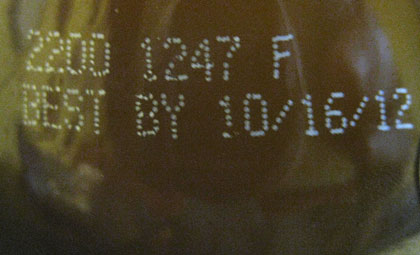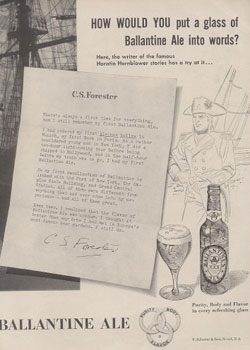(eom) except for a link, of course:
Stone Brewing
Drink them while they are fresh

You might have heard that Stone Brewing released a beer called Stone Enjoy By 09.21.12 IPA in the last few days ago. (That’s not the date on the bottle above, and we will get to that right after explaining what Stone is doing.)
Stone released 09.21.12 only in Chicago, New Jersey and Southern California, and come Sept. 21 (also a Friday) “if any beer remains on the shelf it will be immediately removed.” A press release calls this a “35-day package-to-drink cycle.” Most Stone beers list a shelf life of 90 days, some longer.
Stone head brewer Mitch Steele talks about brewing the beer, the hop additions, and the hops used as well as the volatile nature of hop aroma in this Double IPA in this video from Stone.
Of course other beers dosed with large amounts of late hops — at or near the end of boiling, then in dry hopping — are just as fragile. (Yes, I just use IPA and fragile in the same sentence.)
Research at Sierra Nevada Brewing has determined the levels of the compounds that produce those floral, spicy, etc. aromas that have made highly hopped beers so popular drop dramatically the first three days after bottling. They migrate from the liquid to the head space to the liner of the bottle cap, and perhaps eventually into the atmosphere. After three days an “average” IPA might contain the same level of myrcene, for instance, as a pale ale immediately after bottling. How fast the aroma continues to fade in the following weeks depends on many factors, including storage temperature and the amount beer is agitated in shipping.
Just another way that American IPAs are different than the historic India Pale Ales that presumably continued to improve, at least up to a point, during a long boat ride.
The bottle at the top is Boulevard Brewing’s new 80-Acre Hoppy Wheat Beer.1
What struck me as I poured a bottle into a glass last week was, first, that the hop2 aroma (fresh citrus, like buying pineapples fresh where they are grown) jumps from the glass when it still two feet from your nose — but, then, the “best by” date, only a little more than two months off. This on a bottle just released. That’s a short lease.
Turns out that Boulevard does not plan to continue to keep the date Stone-short (a new phrase that makes sense only within the context of this post). Julie Weeks at Boulevard emailed this explanation from brewmaster Steven Pauwels:
“When we introduce a new beer we want to make sure that the customer has a chance to taste the beer the first time at its optimum. Any new beer in our heritage line-up gets short coded during the launch-phase to make sure the consumer gets to taste it as fresh as possible.
“During the development phase we work a lot on stability and come up with best by date that we confirm with real life data when the beer gets to market.”
I will continue to seek out this beer as fresh as I can get it, and I hope on tap. It’s 5.4% ABV, so not officially a “session beer” but one you can have a few of during the course of a Saturday afternoon watching college football. And there’s a lot more hop going on than the 20 IBUs would suggest (Blue Moon White has 18 IBUs, Fat Tire 19 IBUs), a reminder that hops are about a lot more than bitterness.
Which, of course, is the point of Stone Enjoy By 09.21.12 IPA.
****
1 Extra credit if when you saw the beer name the first time you thought of James McMurtry’s “60 Acres.”
2 If you can keep up with Jeremy Danner on Twitter you know “Bittering is a blend of CTZ, Bravo, & Summit. Cascade in the whirlpool and Cascade and Nelson (Sauvin) for dry hops.”
The good, the bad and the feel good
The good
First we’ve got the Chicago Tribune update: “The world of Chicago-made beer is expanding so quickly — at a rate unseen in the lives of modern-day beer lovers — that new entries arrive almost monthly.” A complete rundown.
There’s there’s the Boston Globe: “Region awash in new wave of niche breweries.” Includes the big question (and no answer), “How many will survive the long haul? No one knows.”
The other day I had a quick keep-it-to-less-than-140-characters exchange with a professional brewer not in St. Louis. He asked, in view of the number of relatively new breweries and additional ones about to open here, how many I think the region can support. I copped out and answered I’m too new to town to guess.
The answer is that a lot more [xxx]¹ beer is going to be sold annually. Will it be more Stone beers (just came into town with lots of fanfare), more Perennial beers (not open yet), more Schlafly (celebrating its 20th anniversary), more Urban Chestnut, Boulevard, Green Flash, beers imported by Shelton Brothers? Can’t tell you, but it will be a lot more. I hope quality makes a difference, but that won’t be the only factor.
¹ Insert whatever term you want: craft, boutique, microbrewed.
The bad
“America’s Finest Beer Festival” in San Diego was canceled rather last minute. There’s a joke in there involving the word “finest” but I sense some people might have got screwed here. A strange story.
The feel good
Stone Brewing has guaranteed that the Japanese Red Cross Society will receive at least $50,000 from its latest collaboration beer, Baird/Ishii/Stone Japanese Green Tea IPA. Toshi Ishii — a former intern-then-brewer at Stone and now owner of Ishii Brewing in Guam — contacted Stone brewmaster Mitch Stone Steele after the Japanese earthquake and tsunami disaster about brewing a beer that would aid the recovery effort. Bryan Baird of Baird Brewing in Numazu made it a threesome.
The beer is “‘dry-hopped’ with Sencha, a variety of whole-leaf Japanese green tea.” Details are at the Stone Blog, but between the tea and various hops the beer certainly makes a green, herbal impression.
Beyond the obvious relief for Japan, hop growers in France may also benefit. After France lost Alsace-Lorraine to German in 1871 and nearly until World War I the region was second only to Bavaria in hop production in the Germany empire. Not all the hops grown in the Alsace had a great reputation, but Strisselspalter (or Strisselspalt, depending on the catalog you are using) is wonderfully aromatic and spicy.
Strisselspalter accounted for 82% of the hops grown in the Alsace in 2008, and production dove 53% in 2009. There are a variety reasons, one of which is that it’s a low alpha hop. Even at a time when [xxx]¹ brewers put a growing premium on aroma quality they want more alpha than the hop provides.
Aramis is a new variety from the growers in the Alsace, with about twice the alpha acids (8 AAUs, so not a heavyweight) and many of the same flavor and aroma qualities as Strisselspalter. According to the Stone Blog this might be the first commercial beer made with Aramis. Given the complex hop recipe and presence of green tea you wouldn’t call it a showcase for Aramis, but you gotta think it’s going to start showing up in other beers. Reason for hop growers in the Alsace to hope.
Stone six-pack prices going up today
 Now this is getting personal.
Now this is getting personal.
Stone XII will not be a hop bomb.
Kind of takes your breath away, doesn’t it? It gets worse. Ballast Point has quit bottling Dorado, one of the style-defining Double (some say Imperial) IPAs. A beer that a beer brewing chemist once described this way: “‘Savage’ flavor but not taste. Hoppy. Hoppy. Hop. Hop.”
Pete Rowe of the San Diego Union-Tribune (who consistently offers some of the best daily newspaper reporting on beer) gets down and dirty with what the hop shortage means in San Diego.
We knew higher beer prices were coming (and in some cases had already arrived). Rowe reports six-packs from Stone Brewing, most of which cost $7.99, will be marked up an additional $1 to $1.50 as of today.
The choice would be to change recipes, and to abandon Stone’s bold hop signature. Co-founder Greg Koch said that won’t be happening.
Koch insisted that the brewery’s regular lineup of beers, including Arrogant Bastard Ale, will remain as aggressively hopped as ever. But the Escondido brewery has been forced to make some changes.
Every summer, Stone issues an anniversary ale (the year marked by Roman numerals), a brew that typically reflects the company’s belief that hops are bitter and more hops are better.
Not this year. “That decision has been made for us,” Koch said. “It won’t be über-hoppy, as anniversary ales have been in the past.”
Rowe’s got more news from San Diego — hmmm . . . Pure Hoppiness — but also asks the elephant-in-the-room-question.
Will drinkers abandon Sierra Nevada, Green Flash, et al. for cheaper, mass-marketed beer?
Koch answers that question with a question.
“Or will they buy less? There are a lot of question marks out there.”
Beer geeks and bookworms
So how come we don’t call beer geeks beerworms? Maybe because it sounds gross, but then why doesn’t bookworm?
Blame Stone Brewing in California – those otherwise sometime arrogant folks – for this question. Stone next month (June 4) initiates a Book & A Beer Club On the Grass at its modestly named World Bistro and Garden.
From the press release:
If this seems suspiciously similar to the type of activity enjoyed by little old ladies at the neighborhood Rec. Center, guess again. Instead of tea and biscuits—32 taps of beer and Arrogant Bastard Onion Rings! Imagine the possibilities…
 I’m a sucker for the beer and book connection. It’s so civilized. After all, Brother Joris – the monk in charge of brewing the coveted Westvleteren beers – is also the librarian at the abbey Saint Sixtus where the beers are produced.
I’m a sucker for the beer and book connection. It’s so civilized. After all, Brother Joris – the monk in charge of brewing the coveted Westvleteren beers – is also the librarian at the abbey Saint Sixtus where the beers are produced.
Back in the early 1950s, Ballantine Ale sought endorsements from many famous artists, including Ernest Hemingway and John Steinbeck. This one is from C.S. Forrester, with his answer to the question “How do you put a glass of Ballantine Ale into words?”
“There’s always a first time for everything. And I still remember my first Ballantine Ale.
“I had ordered my first helles in Munich, my first bock in Paris. As a rather bewildered young man in New York, I did a two-hour sight-seeing tour before being shipped to Hollywood, and in the half-hour before my train was to go, I had my first Ballantine Ale.
“So my first recollection of Ballantine is linked with the Port of New York, the Empire State Building, and Grand Central Station. All of them were different from anything that had ever come into my experience – and all of them great.
“Even then, I realized that the flavor of Ballantine Ale was unique. I thought it better than any brew I had met in Europe’s most famous beer gardens. I still do.”
Back to June 4 at Stone.
The first book up is The Omnivore’s Dilemma, the best book I read last year. Michael Pollan’s examination of industrial corn (the first section) seems to become more important daily (jeez, even affecting beer prices), but the second section (pastoral grass) is my favorite part of the book.
If you live close enough to Escondido to consider dropping by they’d appreciate an RSVP.
<